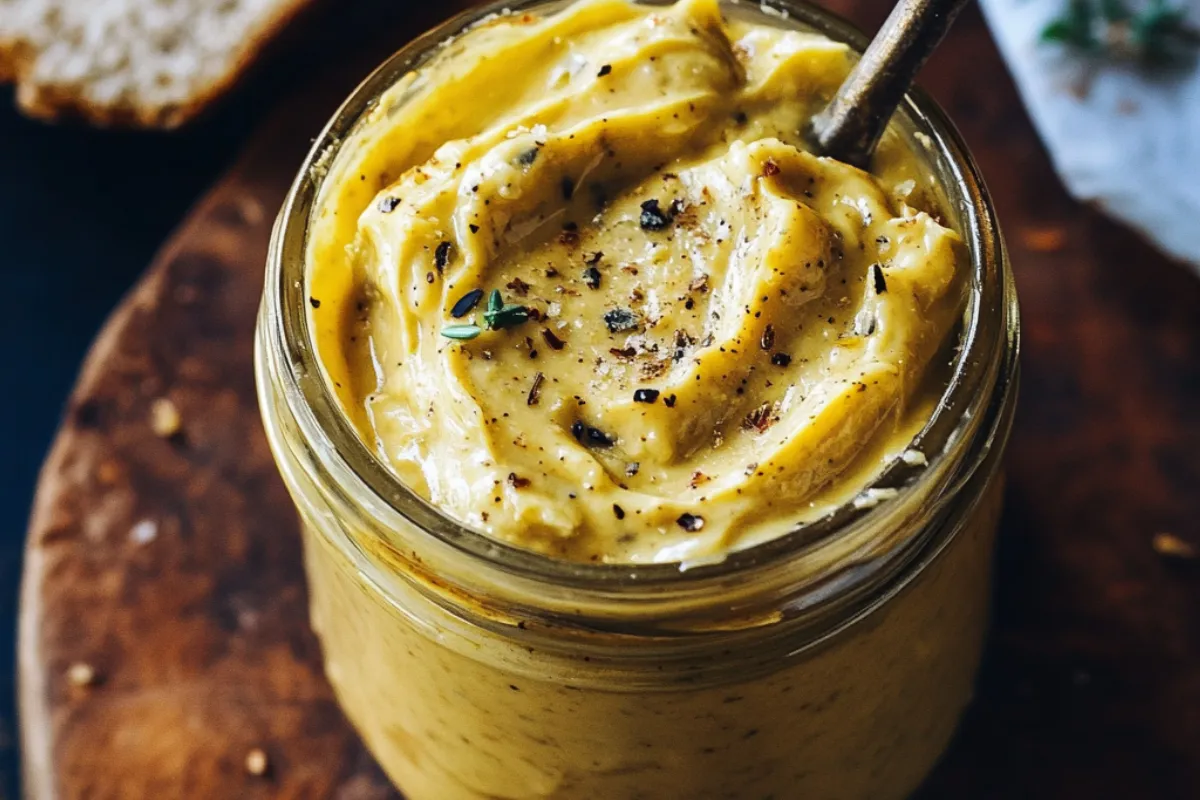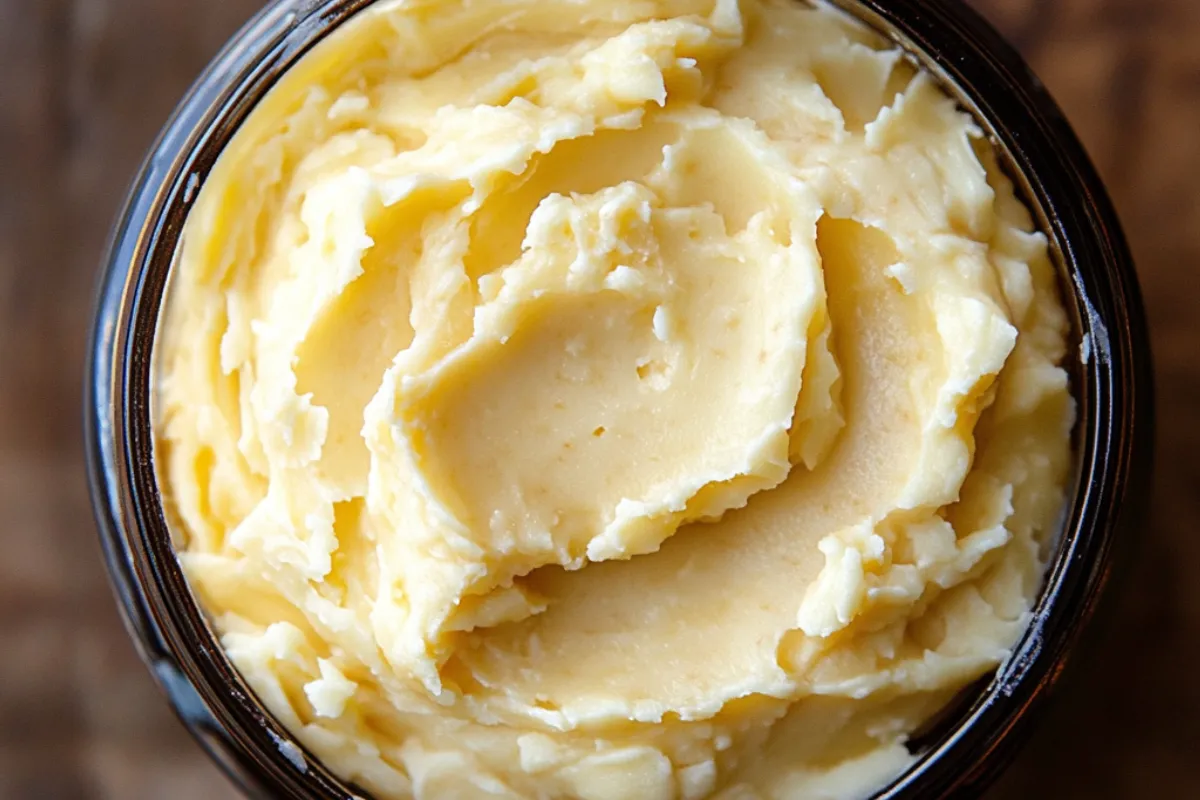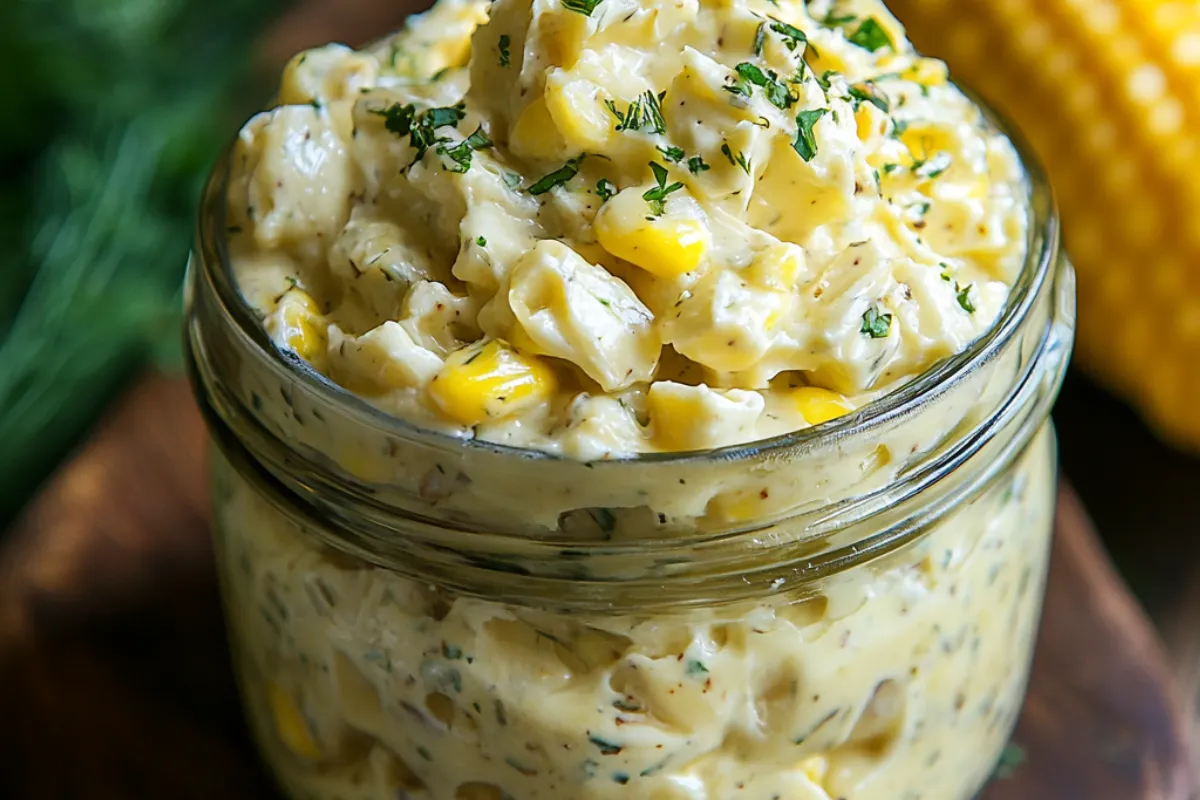The Cowboy Butter Recipe is a must-try for anyone looking to elevate their dishes with bold flavors. This versatile butter combines creamy, unsalted butter with an array of spices, fresh herbs, and tangy ingredients, making it the perfect choice for grilled steaks, seafood, roasted vegetables, and bread. Whether you’re a seasoned chef or a home cook, this Cowboy Butter Recipe is easy to make and will quickly become a staple in your kitchen.
But what exactly is cowboy butter? Unlike traditional compound butters, this butter has a unique twist. It combines rich creamy butter with spicy, smoky, and tangy ingredients that deliver a kick of flavor to every bite. Therefore, it’s a versatile condiment that’s perfect for steaks, seafood, roasted veggies, and even as a dipping sauce. If you want to learn more about the best ways to use compound butters, check out these Creative Uses for Compound Butter.
Furthermore, choosing the right butter is crucial to making a good cowboy butter. With so many butter brands on the market, it’s essential to find one that will stand up to the bold flavors of this recipe. To get an in-depth guide on which butter brands to use, consider exploring the Best Butter Brands for Cooking. Now, let’s dive into what cowboy butter is, its ingredients, and how to make it step-by-step.
What is Cowboy Butter Recipe?

At its core, cowboy butter is a compound butter made by combining softened butter with a mix of herbs, spices, and other flavorful ingredients. It originated from Western American cuisine, where ranchers and cowboys needed a flavorful and convenient condiment to complement their grilled meats. Over time, it has evolved into a sophisticated yet straightforward recipe that’s packed with spicy, tangy, and fresh flavors.
Moreover, the standout ingredients in cowboy butter include garlic, lemon zest, and Dijon mustard, which add a zesty punch, while smoked paprika and red pepper flakes lend a smoky heat. This combination is what makes cowboy butter unique and perfect for a range of dishes—from steaks and seafood to bread and grilled vegetables.
History and Origins of Cowboy Butter Recipe
Cowboy Butter has its roots in the rugged landscapes of the American West, where it was crafted by cowboys and ranchers looking for a simple yet flavorful way to elevate their campfire meals. During the days of cattle drives and frontier life, practicality and flavor were key considerations for those who spent long hours working on the range. Because of this, they often turned to versatile ingredients that were easy to pack, store, and prepare.
Initially, cowboy butter was made with freshly churned butter, mixed with whatever herbs and spices were readily available on the trail. These early versions of cowboy butter were likely more rustic and less complex than modern recipes. However, its main function remained the same: to enhance the taste of grilled meats like steak, brisket, and game. Ranchers would melt this herb-infused butter over their cooked meats, adding much-needed flavor and moisture.
The Evolution of Cowboy Butter
As time passed and frontier life became less prevalent, the recipe for cowboy butter gradually evolved. What was once a simple combination of butter, salt, and a few herbs has transformed into a rich blend of zesty, spicy, and herbaceous ingredients. Modern recipes now incorporate elements like:
- Lemon juice and zest for a bright, tangy note.
- Dijon mustard for a savory and slightly pungent flavor.
- Smoked paprika for a touch of smokiness.
- Crushed red pepper flakes for a hint of heat.
Each addition brought new layers of flavor to the traditional formula, making cowboy butter more versatile and suitable for a broader range of dishes. Today, it’s not only used on grilled meats but also as a dipping sauce, spread, or vegetable topping.
Why Was It Called “Cowboy Butter”?
The name “Cowboy Butter” pays homage to its origins as a staple in the diet of cowboys and ranch hands. The bold flavors of the butter and its versatility made it a perfect fit for those cooking in rustic outdoor settings. Unlike plain butter, cowboy butter could instantly transform simple meals into something more flavorful and satisfying, making it a cherished companion at the campfire. In essence, it was a practical, one-size-fits-all condiment that added a touch of indulgence to otherwise basic meals.
From the Trails to Modern Kitchens
Over time, cowboy butter made its way from the dusty trails of the American West to the kitchens of home cooks and professional chefs. Its ability to complement a wide variety of dishes has solidified its place in modern cuisine. Today, it’s celebrated not just for its flavor, but for the history and tradition it carries with it.
In recent years, cowboy butter has become a popular recipe shared in food blogs, social media, and cooking shows. Its easy preparation, combined with its versatile flavor profile, has made it a go-to choice for those seeking to add a Western flair to their meals. Many cooks now experiment with different variations, adding new spices, herbs, and even sweet elements, making cowboy butter a creative canvas for flavor exploration.
A Symbol of Simplicity and Flavor
Ultimately, cowboy butter symbolizes the ingenuity and resourcefulness of early American ranchers who needed to create simple, delicious meals with limited resources. While the recipes have changed, the spirit of cowboy butter remains rooted in bold flavors and versatile cooking. Whether you’re at a modern barbecue or enjoying a campfire dinner, cowboy butter continues to be a reminder of its rich culinary heritage and timeless appeal.
Ingredients Needed for Cowboy Butter

Creating cowboy butter at home is not only easy, but it’s also a great way to customize the recipe based on your personal preferences. To get started, here’s a standard ingredient list:
Basic Ingredients
First and foremost, you’ll need:
- 1 cup unsalted butter, softened to room temperature
- 2 tablespoons Dijon mustard, for a tangy kick
- 1 teaspoon smoked paprika, which adds a smoky flavor
- 1/2 teaspoon crushed red pepper flakes, for a touch of heat
- 1 tablespoon lemon zest, providing a burst of citrus
- 1 teaspoon lemon juice, to add brightness
- 2 garlic cloves, minced finely for an aromatic depth
- 1 tablespoon chopped fresh parsley, which adds freshness
- 1 tablespoon chopped fresh chives, giving it a mild onion flavor
- 1/2 teaspoon salt, enhancing all the other flavors
- 1/4 teaspoon freshly ground black pepper, for a slight hint of spice
Optional Ingredients
Additionally, if you want to elevate your cowboy butter even further, consider including some of the following optional ingredients:
- Cayenne pepper (for extra heat, if you like it spicier)
- Lime zest (for a more citrusy profile)
- Tarragon or rosemary (to introduce more herbaceous notes)
- Hot sauce (for an added layer of heat)
Ingredient Breakdown and Why They Matter
Next, it’s essential to understand the role of each ingredient and how they contribute to the overall flavor profile of cowboy butter. For instance:
- Lemon zest and juice add brightness and balance, which helps cut through the richness of the butter.
- Dijon mustard not only provides a tangy depth but also helps emulsify the ingredients, ensuring they blend smoothly.
- Garlic contributes sharpness and an aromatic quality, both of which are crucial for enhancing the overall flavor.
- Smoked paprika and red pepper flakes give the butter its smoky heat, adding complexity to the taste and making the cowboy butter truly stand out.
Overall, these ingredients work harmoniously together, creating a balanced and delicious flavor profile that’s perfect for a variety of dishes.
Ingredient Breakdown and Why They Matter
Each ingredient in cowboy butter plays a crucial role in creating its complex flavor profile. For instance:
- Lemon zest and juice add brightness and cut through the richness of the butter.
- Dijon mustard gives a tangy depth and helps emulsify the ingredients.
- Garlic provides sharpness and aromatic quality, essential for any compound butter.
- Smoked paprika and red pepper flakes contribute a smoky heat, elevating the butter from basic to bold.
Each ingredient in Cowboy Butter Recipe plays a crucial role in creating its complex flavor profile. First, let’s look at the lemon zest and juice, which add brightness and help cut through the richness of the butter. In addition, the Dijon mustard provides a tangy depth while also helping to emulsify all the other ingredients. Meanwhile, garlic gives a sharp and aromatic quality, which is essential for any compound butter. Next, the smoked paprika and red pepper flakes contribute a smoky heat, elevating the butter from a basic spread to a bold and exciting condiment. Moreover, parsley and chives add a fresh, herbaceous note, balancing out the stronger flavors.
Finally, all of these ingredients work together in harmony to create the distinctive taste of cowboy butter, making it truly unique and versatile. Therefore, understanding the role of each component is crucial when adjusting the recipe to suit your specific preferences.
Step-by-Step Guide: How to Make Cowboy Butter

Making Cowboy Butter Recipe at home is straightforward and can be done in just a few minutes. Follow these steps to achieve the perfect consistency and flavor:
Step 1: Soften the Butter
Leave the unsalted butter out at room temperature for about 30 to 60 minutes until it becomes pliable. This step is crucial because soft butter ensures that the other ingredients mix smoothly.
Step 2: Prepare the Ingredients
While the butter softens, prepare the garlic by mincing it finely. Chop the parsley and chives, zest the lemon, and extract the lemon juice. Then, measure out the Dijon mustard, paprika, and crushed red pepper flakes.
Step 3: Mix Everything Together
In a medium-sized bowl, combine the softened butter, Dijon mustard, garlic, lemon zest, lemon juice, paprika, red pepper flakes, parsley, chives, salt, and pepper. Next, use a spatula or fork to mix thoroughly until all the ingredients are well incorporated.
Step 4: Shape the Butter
Once everything is evenly mixed, transfer the butter mixture onto a sheet of parchment paper. Then, roll the mixture into a log shape, twisting the ends of the paper to secure it. This log shape makes it easy to slice off portions as needed.
Step 5: Refrigerate or Freeze
Finally, refrigerate the butter log for at least 2 hours until it firms up. For longer storage, you can freeze the log for up to 6 months. Simply slice into discs for easy use.
Best Ways to Use Cowboy Butter Recipe
Since Cowboy Butter Recipe is incredibly versatile, it can elevate a variety of dishes. Below are some delicious ways to incorporate it into your meals:
1. Steak Sauce
To start, melt Cowboy Butter Recipe over freshly grilled steaks for an indulgent finish. The butter’s rich flavor enhances the meat’s natural juices, creating a perfect blend of spicy, tangy, and herby notes. Moreover, this easy addition will give your steakhouse favorites a professional touch.
2. Seafood Condiment
Additionally, drizzling melted Cowboy Butter Recipe over grilled shrimp, salmon, or lobster adds a burst of flavor. The zesty lemon and smoky paprika pair beautifully with the delicate flavors of seafood, making this an excellent choice for a gourmet seafood experience at home.
3. Chicken Marinade
Furthermore, you can use Cowboy Butter Recipe as a marinade for chicken breasts or thighs before roasting. The butter’s creamy texture helps the flavors penetrate the meat, resulting in juicy, flavorful chicken. As a result, even simple roasted chicken can taste restaurant-quality.
4. Vegetable Dip
Similarly, serve Cowboy Butter Recipe as a dipping sauce for roasted or grilled vegetables like carrots, asparagus, or broccoli. The butter’s bold flavors make even the simplest veggies taste gourmet. Therefore, it’s a great way to get your family excited about eating more vegetables.
5. Bread Spread
Finally, spread cowboy butter on freshly baked bread, baguettes, or cornbread. Additionally, you can also use it as a base for making garlic bread, adding an extra layer of flavor with the spicy mustard and herbs. For a quick snack, consider spreading it on toast or using it as a finishing touch for sandwiches.

